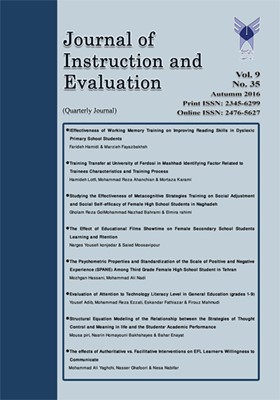Evaluation of Attention to Technology Literacy Level in General Education (grades 1-9)
Subject Areas : Educational PsychologyYousef Adib 1 , Mohammad Reza Ezzati 2 * , Eskandar Fathiazar 3 , Firouz Mahmudi 4
1 - دکترای برنامهریزی درسی و استاد دانشکده علومتربیتی دانشگاه تبریز
2 - دانشجوی دوره دکتری برنامهریزی درسی دانشکده علومتربیتی دانشگاه تبریز
3 - دکترای تعلیم و تربیت و استاد دانشکده علومتربیتی دانشگاه تبریز
4 - دکترای برنامهریزی درسی و استادیاردانشکده علومتربیتی دانشگاه تبریز
Keywords: Content Analysis, Technology literacy, Technology Education, National Curriculum,
Abstract :
In the last three decades, Technology education has been part of the curriculum in public education, with the aim of fostering technology literacy. Technology education or technology literacy is an educational program that assists people to have an understanding and ability in designing and using technology products and systems and assessing the appropriateness of technological actions. This research was conducted to analyze textbook contents with regard to technology literacy elements. The method was content analysis. The population included all textbooks in grades 1 to 9, and the sampling was purposeful in which 24 textbooks were selected and their content were analyzed by two teachers using 20 elements of technology literacy through separate coding. The data were first described in frequency tables and analyzed later. The findings showed that technology literacy elements of understanding the nature and effects of technology are presented insufficiently. Process skills development elements are presented to an acceptable extent but these processes were far from technological processes such as Designing and Troubleshooting which are technological in nature. Also, regarding technological fields, information technology was the dominant content including 3/4 of the content, and little was left to other fields. Therefore, in general, it can be concluded that the new national curriculum is potentially weak and insufficient to develop technology literacy in all its dimensions
References منابع
Bybee, R. (2003). Fulfilling a promise: Standards for technological literacy. The Technology Teacher, 23-26.
Cross, A., & McCormick, R. (1986). Technology in schools. Milton Keynes: Open University Press.
de Klerk Wolters, F. (1989). The attitude of pupils towards technology. Eindhoven: The Netherlands: Eindhoven University of Technology.
Dakers, J. (2006). Toward a philosophy for technology education. New York: Palgrave Macmillan.
Dugger, S. W. (1993). What are the relationship between Technology, Science and Mathmathics? In I. Mottier, J. R. Raat & M. De Vries, Technology Education and the Envirnment Improving Our environment through tecnology education (pp. 174-188). Eindhoven: PATT Foundation.
Dyrenfurth, M. J. (1991). Technology literacy synthesized. In M. J. Dyrenfurth. In M. J. Dyrenfurth & M. Kozak (Eds.), Technological literacy (pp. 138-183). Peoria, , IL: Glencoe/McGrawhill.
Faure, E., Herrera, F., Kaddoura, A. R., & Lopes, H. (1972). Learning to Be: The World of Education Today and Tomorrow. Paris/London.: UNESCO/ Harrap.
Frank, M. (2005). A systems approach for developing technological literacy. Journal of Technology Education, 17(1), 19-34.
Gilbert, J. K. (1992). The Interface between Science Education and Technology Education. International Journal of Science Education, 14(5), 563–578.
International Technology Education Association (ITEA). (1996). Technology for all Americans, a rational and structure for the study of technology. Reston: VA: Author.
International technology education association. (2002). Executive Summary of Standard for Technology literacy: Content for the Study of Technology. reston: ITEA.
Kelley, T., & Kellam, N. (2009). A theoretical framework to Guide the re-engineering of technology education. Journal of Technology Education, 20(2), 37-49.
LaPorte , J. E. (2001). Of melting pots, football drafts, and Professor Jackson. Journal of Technology Education, 12(2), 2-4.
Lewis, T. (2000). Technology Education and Developing Countries. International Journal of Technology and Design Education,10 (2), 163–179.
Mehrmohammadi, M. (2013). Recognition of “technology education” as a null aspect of school curriculum and an exigency in the Islamic world. Journal of Curriculum Studies (J.C.S.), 7(28), 117-138.
Papert, S. (1980). Mindstorms, children, computers and powerful ideas. New York: Basic Books Inc.
Rasinen, A. (2003). An Analysis of the Technology Education Curriculum of Six Countries. Journal of Technology Education , 15(1), 31-47.
Stables, K. (1997). Critical Issues to Consider When Introducing Technology Education into the Curriculum of Young Learners. Journal of Technology Education, 8 (2), 50-65.
Todd, R. (1991). The changing face of technology education in the United States. In J. J. Smith (Ed.), Papers and poster abstracts of the Fourth National Conference in Design (pp. 270-278). Loughborough,, UK: Department of Design and Technology, University of Technology.
Wicklein, R., Cameron , P., & Smith, J. (2009). Essential Concepts of Engineering Design Curriculum in Secondary Technology Education. Journal of Technology Education, 20(2), 65-80.
Williams, P. J. (2001). Design: The Only Methodology of Technology? Journal of Technology Education, 11(2), 34-5.

